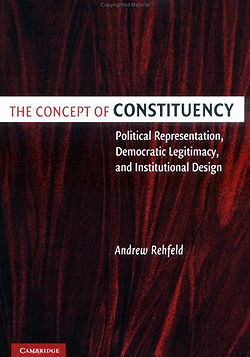Andrew Rehfeld, Ph.D., assistant professor of political science in Arts & Sciences
(Cambridge University Press, 2005)
As a graduate student, Andrew Rehfeld asked his instructor a question that the instructor couldn’t answer. The next day, Rehfeld headed to the library to find a book that could answer his question, but after an hour of searching article databases and other sources, he came up empty.
So he decided to write the book he was looking for: one that would explain the origins of the country’s electoral districts and how they came to be based on where people live.

“It struck me that of all the different ways we as a nation might organize ourselves for political representation, we choose to do so based on where we live,” said Rehfeld, Ph.D., assistant professor of political science in Arts & Sciences. “For example, the fifth district of Illinois is defined by lines in the sand. And it’s not only us. In virtually every democratic representative government, territorial districts are used to group voters as a way of providing political representation. We might have done it by profession or age, religion or party affiliation. So why by where we live?”
Rehfeld breaks his book, The Concept of Constituency, into four distinct parts.
First, conceptually, he realized that territorial districts are simply one way that electoral constituencies might be defined. But in many other nations, they are defined by territory and some other dimension.
The most common is organizing constituencies by how voters vote — this is done in systems of proportional representation where an electoral constituency is formed when we vote for a party.
So the first part of the analysis steps back and tries to make sense of these conceptual distinctions.
The second part of the book takes up the historical question of why in the United States we use territorial districts. Rehfeld found that most people who mentioned the history briefly had written that local districts were used to represent local community interests at a time when people’s lives were more local.
But at the national level — that is, at the level of U.S. Congressional districts — this turns out to be wrong for reasons that the country’s founders explicitly discussed.
“First, opponents of the U.S. Constitution argued that districts would be far too large to represent local interests, and they were right about that,” Rehfeld said. “Prior to the national government, the average state electoral district was about the size of a town or county — about 3,000 people.
“The U.S. Constitution provided for districts of 30,000 people each, 10 times the size of the average state-level district.
The last third of the book takes up the normative or prescriptive questions, such as how we should define electoral constituencies in today’s world.
Rehfeld argues that territorial representation is not so good; it can introduce perverse incentives for political representatives to create ways to service their constituents by local pork at the expense of the national good.
“If you think that constituencies should be represented by interests, then you need to explain how a district of roughly 500,000 people (larger than the City of St. Louis) has one coherent interest and why that coherent interest rather than some other (like profession, hobby, political party) should be represented,” Rehfeld said. “That is, if you think interests should be represented by our representatives, why pick those that are local?”
Rehfeld wraps up the book by proposing an alternative, imagining that all 435 seats in Congress were no longer based on territory, but still single-member districts containing a random distribution of voters.
When voters register, they get randomly assigned to one of the 435 districts.
This would have the effect of creating 435 identical districts justifiable for various reasons he discusses in the book.
While the subject might seem heady, Rehfeld took the same approach to writing that he asks of his students.
“I wanted to write this book to pass the ‘grandmother test’ that I tell my students they should follow themselves: Would your grandmother understand the argument that’s made, whether she can evaluate it or not?” he said.
“That was my goal: Could my grandmother understand the book?”
— Andy Clendennen